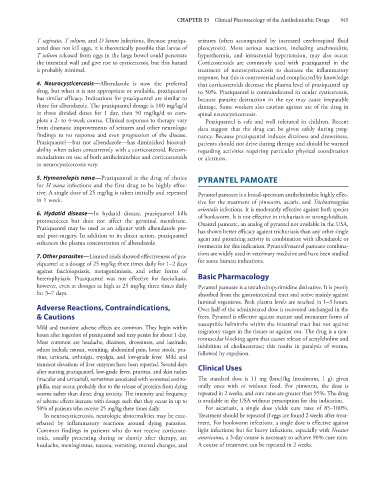Page 959 - Basic _ Clinical Pharmacology ( PDFDrive )
P. 959
CHAPTER 53 Clinical Pharmacology of the Antihelminthic Drugs 945
T saginata, T solium, and D latum infections. Because praziqu- seizures (often accompanied by increased cerebrospinal fluid
antel does not kill eggs, it is theoretically possible that larvae of pleocytosis). More serious reactions, including arachnoiditis,
T solium released from eggs in the large bowel could penetrate hyperthermia, and intracranial hypertension, may also occur.
the intestinal wall and give rise to cysticercosis, but this hazard Corticosteroids are commonly used with praziquantel in the
is probably minimal. treatment of neurocysticercosis to decrease the inflammatory
response, but this is controversial and complicated by knowledge
4. Neurocysticercosis—Albendazole is now the preferred that corticosteroids decrease the plasma level of praziquantel up
drug, but when it is not appropriate or available, praziquantel to 50%. Praziquantel is contraindicated in ocular cysticercosis,
has similar efficacy. Indications for praziquantel are similar to because parasite destruction in the eye may cause irreparable
those for albendazole. The praziquantel dosage is 100 mg/kg/d damage. Some workers also caution against use of the drug in
in three divided doses for 1 day, then 50 mg/kg/d to com- spinal neurocysticercosis.
plete a 2- to 4-week course. Clinical responses to therapy vary Praziquantel is safe and well tolerated in children. Recent
from dramatic improvements of seizures and other neurologic data suggest that the drug can be given safely during preg-
findings to no response and even progression of the disease. nancy. Because praziquantel induces dizziness and drowsiness,
Praziquantel—but not albendazole—has diminished bioavail- patients should not drive during therapy and should be warned
ability when taken concurrently with a corticosteroid. Recom- regarding activities requiring particular physical coordination
mendations on use of both antihelminthics and corticosteroids or alertness.
in neurocysticercosis vary.
5. Hymenolepis nana—Praziquantel is the drug of choice PYRANTEL PAMOATE
for H nana infections and the first drug to be highly effec-
tive. A single dose of 25 mg/kg is taken initially and repeated Pyrantel pamoate is a broad-spectrum antihelminthic highly effec-
in 1 week. tive for the treatment of pinworm, ascaris, and Trichostrongylus
orientalis infections. It is moderately effective against both species
6. Hydatid disease—In hydatid disease, praziquantel kills of hookworm. It is not effective in trichuriasis or strongyloidiasis.
protoscoleces but does not affect the germinal membrane. Oxantel pamoate, an analog of pyrantel not available in the USA,
Praziquantel may be used as an adjunct with albendazole pre- has shown better efficacy against trichuriasis than any other single
and post-surgery. In addition to its direct action, praziquantel agent and promising activity in combination with albendazole or
enhances the plasma concentration of albendazole.
ivermectin for this indication. Pyrantel/oxantel pamoate combina-
7. Other parasites—Limited trials showed effectiveness of pra- tions are widely used in veterinary medicine and have been studied
ziquantel at a dosage of 25 mg/kg three times daily for 1–2 days for some human indications.
against fasciolopsiasis, metagonimiasis, and other forms of
heterophyiasis. Praziquantel was not effective for fascioliasis, Basic Pharmacology
however, even at dosages as high as 25 mg/kg three times daily Pyrantel pamoate is a tetrahydropyrimidine derivative. It is poorly
for 3–7 days. absorbed from the gastrointestinal tract and active mainly against
luminal organisms. Peak plasma levels are reached in 1–3 hours.
Adverse Reactions, Contraindications, Over half of the administered dose is recovered unchanged in the
& Cautions feces. Pyrantel is effective against mature and immature forms of
susceptible helminths within the intestinal tract but not against
Mild and transient adverse effects are common. They begin within
hours after ingestion of praziquantel and may persist for about 1 day. migratory stages in the tissues or against ova. The drug is a neu-
Most common are headache, dizziness, drowsiness, and lassitude; romuscular blocking agent that causes release of acetylcholine and
others include nausea, vomiting, abdominal pain, loose stools, pru- inhibition of cholinesterase; this results in paralysis of worms,
ritus, urticaria, arthralgia, myalgia, and low-grade fever. Mild and followed by expulsion.
transient elevations of liver enzymes have been reported. Several days Clinical Uses
after starting praziquantel, low-grade fever, pruritus, and skin rashes
(macular and urticarial), sometimes associated with worsened eosino- The standard dose is 11 mg (base)/kg (maximum, 1 g), given
philia, may occur, probably due to the release of proteins from dying orally once with or without food. For pinworm, the dose is
worms rather than direct drug toxicity. The intensity and frequency repeated in 2 weeks, and cure rates are greater than 95%. The drug
of adverse effects increase with dosage such that they occur in up to is available in the USA without prescription for this indication.
50% of patients who receive 25 mg/kg three times daily. For ascariasis, a single dose yields cure rates of 85–100%.
In neurocysticercosis, neurologic abnormalities may be exac- Treatment should be repeated if eggs are found 2 weeks after treat-
erbated by inflammatory reactions around dying parasites. ment. For hookworm infections, a single dose is effective against
Common findings in patients who do not receive corticoste- light infections; but for heavy infections, especially with Necator
roids, usually presenting during or shortly after therapy, are americanus, a 3-day course is necessary to achieve 90% cure rates.
headache, meningismus, nausea, vomiting, mental changes, and A course of treatment can be repeated in 2 weeks.

